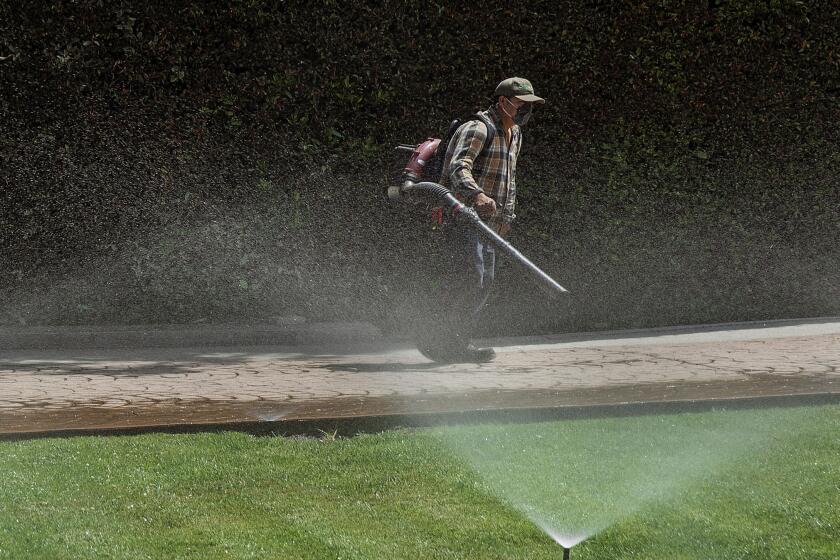Paradise Found
- Share via
Southern California gardeners aren’t granted the advantage of humidity that’s available to Hawaiians and other islanders, but we do have the perfect climate for growing many tropical and subtropical plants.
“Plumeria, ginger and cannas thrive here,” said garden designer Steve Kawaratani, who owns Landscapes by Laguna Nursery in Laguna Beach. “It’s easier than you might think to create a tropical paradise.”
Besides providing the garden with colorful flowers and large, exotic foliage, tropical gardens are also very low maintenance, said Long Beach horticulturist Kelley Zunich. “Occasionally you’ll have to pick up a leaf or cut off dead foliage, but there is very little pruning required. Tropical plants generally don’t grow out of hand, but stay in perspective of the garden.”
The secret to creating a backyard oasis is to use plants that like our Mediterranean conditions, said Zunich, who specializes in landscape maintenance.
“It’s important to remember that we live in a desert,” Zunich said. “Plants that require very high humidity and lots of water probably won’t do well. But there are plenty of things that are tropical or look tropical that will do just fine here.”
Brian Jacob, a horticulturist with Monrovia, an Azusa-based grower whose plants can be found throughout Orange County nurseries, agreed.
“Thanks to hybridizing and advances in plant propagation, some popular tropicals also have dwarf forms that are better suited for small yards,” he said.
Bougainvillea is generally a large vine, but Monrovia has two small, thornless shrubby varieties that grow 3 to 4 feet wide and tall. ‘Ms. Alice’ comes in white and ‘Silhouette’ is a soft pink.
Bananas are another good choice for a tropical garden, and they also come in dwarf forms. There are edible and ornamental varieties.
When creating a tropical landscape, experts suggest choosing a wide variety of plants and creating the landscape in layers.
“If you visit the tropics, and the jungle in particular, you’ll see that there are distinct layers of plants,” Kawaratani said.
“The first layer consists of larger trees; the second, smaller trees; under that flowering shrubs and vines; and then at the bottom, small plants and ground covers,” he said. “While the larger trees provide a great deal of shade, there are still occasional pockets of sunlight in the understory for flowering plants.”
Larger trees should be chosen first. They are the most important and conspicuous element of the garden, so choose them wisely. Make sure that the trees will fit in the yard at maturity. If you are installing a tree with potentially invasive roots, use root barriers at planting time to force the roots down, rather than out toward structures and cement areas.
“Exercise some caution when choosing tropical trees, particularly certain ficus, coral trees, palms and draceanas, which can get very large,” Kawaratani said.
Some good smaller-size trees for tropical landscapes include schefflera, Hong Kong orchid tree (Bauhinia blakeana), Purple orchid tree (Bauhinia variegata), naked coral tree (Erythrina coralloides) and some acacias.
Depending on the variety, some trees take a long time to grow large enough to provide adequate shade for understory plants. In the meantime, use shade cloth to develop temporary canopies that will simulate tropical conditions. Like established trees, shade cloth will cut down on sunlight and wind and will trap in moisture. Once the trees get larger, the canopies can be removed.
The second tier of plants, which includes short trees, grow under the top story of trees. When choosing this group, look for lush plants with large, sweeping foliage. Some likely candidates include the Mediterranean fan palm (Phoenix rubbelini), windmill palm (Kentia palm), small bird of paradise (Strelitzia reginae), schefflera, various draceanas, angel’s trumpet (Brugmansia), sapote, guava and banana.
For the third level, consider shrubs and large perennials, such as hibiscus, plumeria, gardenia, taro (Colocasia esulenta) and heavenly bamboo ( Nandina domestica).
Don’t forget vines. Fill in areas that need shade and privacy with vines that lend a tropical look to the landscape, such as passion vine, mandevilla, dipladenia, star jasmine and bougainvillea.
Last are small plants. For shady areas, use plants that are typically grown indoors such as split-leaf philodendron (Monstera deliciosa), cast-iron plant (Aspidistra elatior), Chinese evergreen (Aglaonema modestum) and peace lily (Spathiphyllum).
It’s also a good idea to bring in temporary color. Some good choices include caladium and coleus for their foliage. When they’re in flower, bromeliad, tillandsia, epiphyllum and various orchids make good temporary accents. Zunich likes to bury clay pots in the ground, which she fills with whatever is in flower.
“I’ll put an orchid or bromeliad in the pot and cover the top with sphagnum moss, so it looks as if the plant is growing right out of the ground,” she said.
At the foot of your jungle floor, add mulch, which will keep your plants cool and humidity high.
* Landscapes by Laguna Nursery, (949) 497-2438.
* For a retailer that carries Monrovia plants, call (800) 752-6848.






